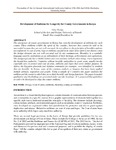| dc.description.abstract | The emergence of county governments in Kenya has seen the development of emblems for each
county. These emblems exhibit the spirit of the counties, however they cannot be said to be
successful because they are not well executed, do not adhere to the principles of heraldry and are
not registered. A coat of arms, logo or emblem, can fail in its object if its spirit is not shared, when
the design elements are not well executed and do not communicate. Heraldry, is a symbolic
language used by institutions as an embodiment of their heritage, achievements and aspirations.
The design typically has a shield, helmet and crest and may include other things. Once registered,
the herald has authority. Countries without heraldic authorities to grant arms, usually invoke
copyright laws to protect and coat of arms, emblems and logos that serve similar purpose. In
Africa, the Egyptian pharaohs and Adinkra community for example, were identified by symbols
that are heraldic. In Kenya, some of the common symbols or imagery that have been applied
include animals, vegetation and people. Using a sample of 5 counties this paper analyses the
emblem and the extent to which they serve their heraldic and design functions. The paper is mainly
qualitative and the findings are presented under specific headings . It is proposed that guidelines
or policy be developed to align the county emblems.
Key words: Design, Coat of arms, emblems, heraldry, county governments. | en_US |

